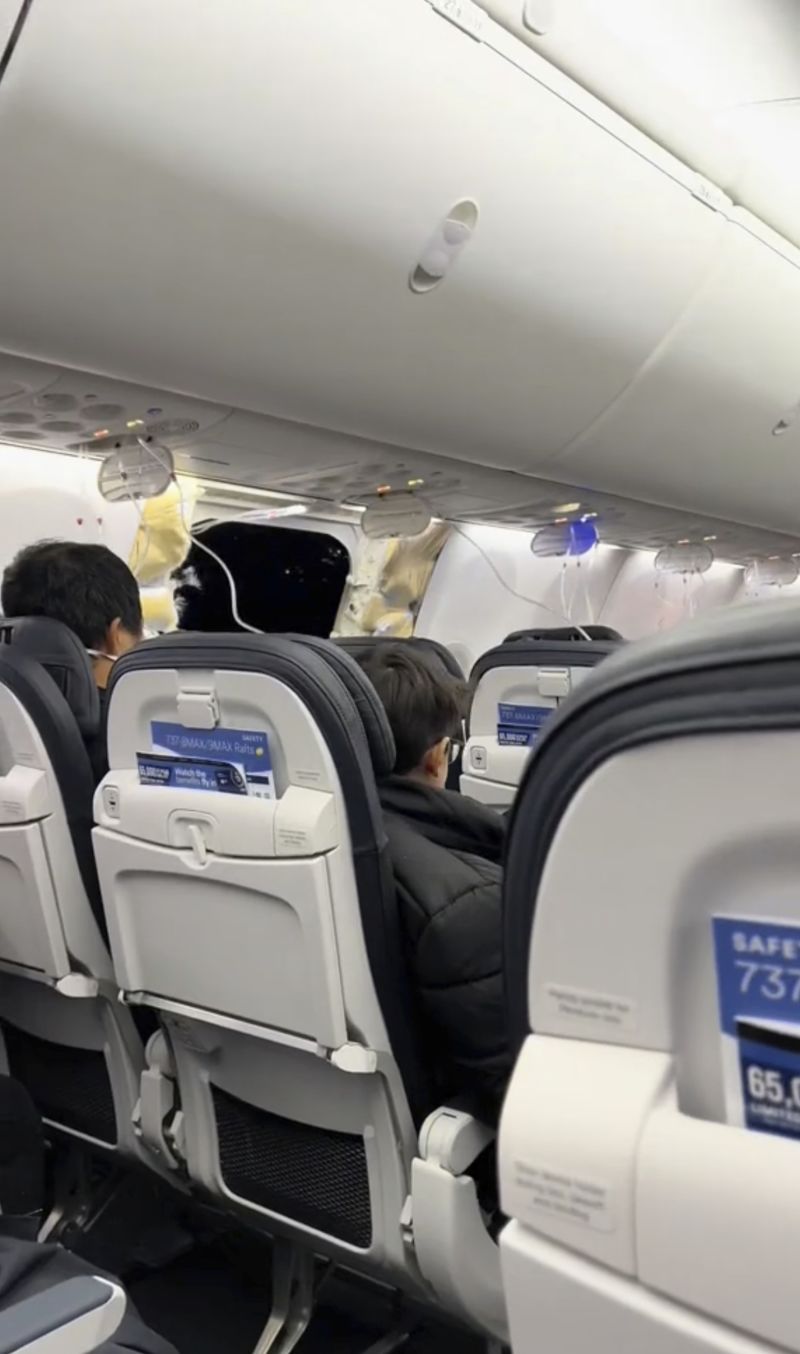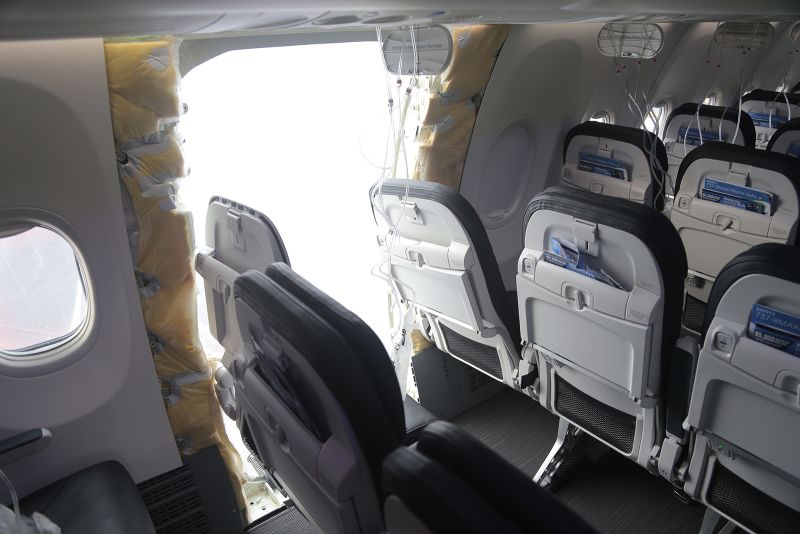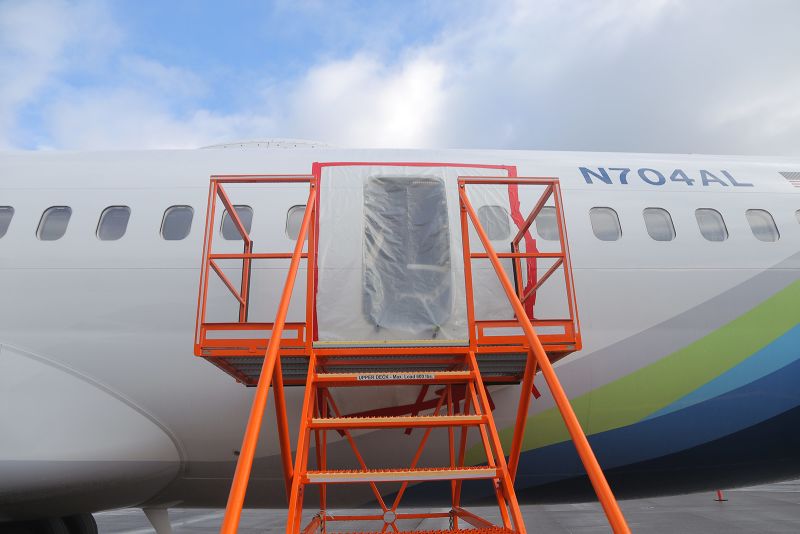
Update on Alaska Airlines Plane: Missing Part Recovered in Portland, NTSB Reveals

Alaska Airlines plane's missing part found in Portland, providing new details as federal investigators reveal preliminary findings Restricted from flying over water due to pressurization fail lights, interviews with crew and interior damage indicate a terrifying scene Missing crucial evidence due to cockpit recorder setting, but fallen cell phones may offer valuable insights
The investigation into the Alaska Airlines aircraft is entering its second day and new details are emerging on the aircrafts history and the terrifying ordeal.
Heres the latest from investigators:
Federal authorities investigating the terrifying in-flight blowout of an Alaska Airlines aircraft have revealed that the missing piece of the plane has been located. This discovery is crucial to understanding the cause of the plane's explosive decompression. According to NTSB Chair Jennifer Homendy, a Portland school teacher found the refrigerator-sized Boeing 737 MAX 9 fuselage door plug in his yard and reported it to the National Transportation Safety Board during a news conference on Sunday night.
The plug door went missing when it blew off an Alaska Airlines aircraft on Friday, creating a large hole in the side of the plane as it flew at 16,000 feet soon after departing from Portland. The frightening incident, in which headrests were torn off and items were sucked out of the cabin, resulted in the grounding of specific Boeing 737 MAX 9 aircraft nationwide and numerous flight cancellations.
"It must have been a terrifying event to experience," remarked Homendy on Sunday after witnessing the chaotic aftermath of the airplane's interior, which showed damage in multiple rows.
As the investigation enters its second day, NTSB officials will continue to carefully inspect the inside of the aircraft and make preparations to recover and analyze the detached door plug, Homendy stated.
Efforts are further complicated by the absence of crucial cockpit audio recordings due to a device configuration issue, according to Homendy.
Plane was restricted from flying over water amid auto pressurization fail lights
Alaska Airlines had imposed a restriction on flying the plane over the ocean to Hawaii in order to guarantee a "quick return to an airport" in the event of any warning lights going off in the aircraft, as stated by Homendy.
This photo, taken from a video by Elizabeth Le, captures passengers in proximity to the damage on an Alaska Airlines Boeing 737 Max 9, Flight 1282, as it was compelled to return to Portland International Airport on Friday, Jan. 5, 2024.
Elizabeth Le via AP
Boeing 737 MAX 9 planes grounded after Alaska Airlines emergency landing, leading to travel delays and cancellations
The decision was made because the plane's auto pressurization fail light had come on three times in the last month, according to Homendy. It is uncertain whether there is a connection between the warning lights and the incident on Friday. The fail light appeared on December 7, as well as on January 3 and 4, right before the blowout. The flight crew responded by activating the system's backup each time, which Homendy described as a routine procedure.
"They flipped, reported, and tested it before resetting it. Additional maintenance was ordered to address the incomplete light (related to the fuselage blowout). Further investigation is planned, and documentation on all defects since the aircraft's delivery on October 31 has been requested," she stated.
CNN has requested a response from Alaska Airlines regarding the plane's flight restriction and warning lights.
The Boeing 737 Max 9 involved in Friday's incident had been in service for approximately three months and has flown about 150 times since October 2023, according to FlightAware and FAA records.
Crew interviews, interior damage illustrate terrifying scene
The NTSB released this image of the aircraft from Alaska Airlines Flight 1282.
National Transportation Safety Board
The interviews with flight crew members and the investigations of the wreckage inside the cabin provided insight into the turbulent and chaotic atmosphere within the aircraft when the plug door was ripped off, leading to a powerful depressurization. The NTSB chief reported that flight attendants quickly rushed to the aid of children on the flight after the "violent" incident. Following the sudden decompression, flight attendants worked urgently to ensure that the four unaccompanied minors on board were equipped with oxygen masks and lap belts, earning praise from Homendy as "heroic."
Communication posed a serious issue between the pilots and flight attendants, with the latter expressing challenges in efficiently sharing information, she elaborated. "I want to highlight the incredible actions of the flight crew," she added.
The event's impact resulted in damage to the non-critical interior paneling, trim, and plastic around the windows inside the aircraft, as stated by Homendy. Additionally, the damage affected multiple rows of the plane, not just the one adjacent to the breach.
The seats next to the door, 26A and 26B, were unoccupied at the time of the blowout, but their headrests had been ripped off, as mentioned earlier. The back of seat 26A is now completely destroyed.
It was also pointed out that there was no structural damage to the aircraft or its frame.
Alaska Airlines has said it is working with Boeing to understand what happened on Flight 1282.
Cockpit recorder setting wipes crucial evidence
Homendy said that the cockpit voice recorder, which records engine noises and pilots' voices, was "completely overwritten" as current devices are only mandated to store two hours of audio at a time.
A passenger sent this picture from inside the aircraft after the landing on Friday.
Kyle Rinker
Alaska Airlines anticipates ongoing flight disruptions due to extended FAA inspections of 737 Max 9 aircraft.
"The cockpit voice recorder yielded no new information," she reported, adding that the maintenance team retrieved the recorder after the two-hour mark when a new recording cycle began.
The recorded audio is crucial for investigators to understand the details of the incident, according to Homendy. Without it, there is no record of communications between pilots and flight attendants as the crisis unfolded. "If that communication is not recorded, it is unfortunately a loss for the NTSB, the FAA, and aviation safety improvement," Homendy stated.
Homendy emphasized the importance of extending cockpit voice recordings to 25 hours for all aircraft, calling on the FAA and Congress to make it a requirement. While the FAA has proposed this rule for new aircraft, it does not mandate older aircraft to be retrofitted with the extended recording capability.
CNN has sought comment from the airline on the wiped cockpit audio.
The NTSB shared this image of the Alaska Airlines aircraft as they investigate the blown plug door.
National Transportation Safety Board
Fallen cell phones may provide insight
Two mobile phones, which were presumably thrown from the aircraft, were discovered in a yard and on the roadside, and handed over to investigators. These devices could potentially serve as valuable evidence, as stated by Homendy.
"The agency chief mentioned how cell phones have been useful in determining post-tragedy events and questioning whether we are focusing on the right area," Shortly after, the door plug was discovered. Sean Bates informed CNN that he found a phone on an Oregon roadside and handed it over to the NTSB, who were already investigating the accident in the vicinity.
The phone did not have a security lock, and a photo of the phone revealed an emailed Alaska Airlines baggage receipt for two bags, according to Bates.
NTSB spokesperson Jennifer Gabris informed CNN that the agency acquired the phone on Sunday and has since returned it to Alaska Airlines.
CNNs Gregory Wallace, Joe Sutton, Mike Valerio and Anna-Maja Rappard contributed to this report.

















